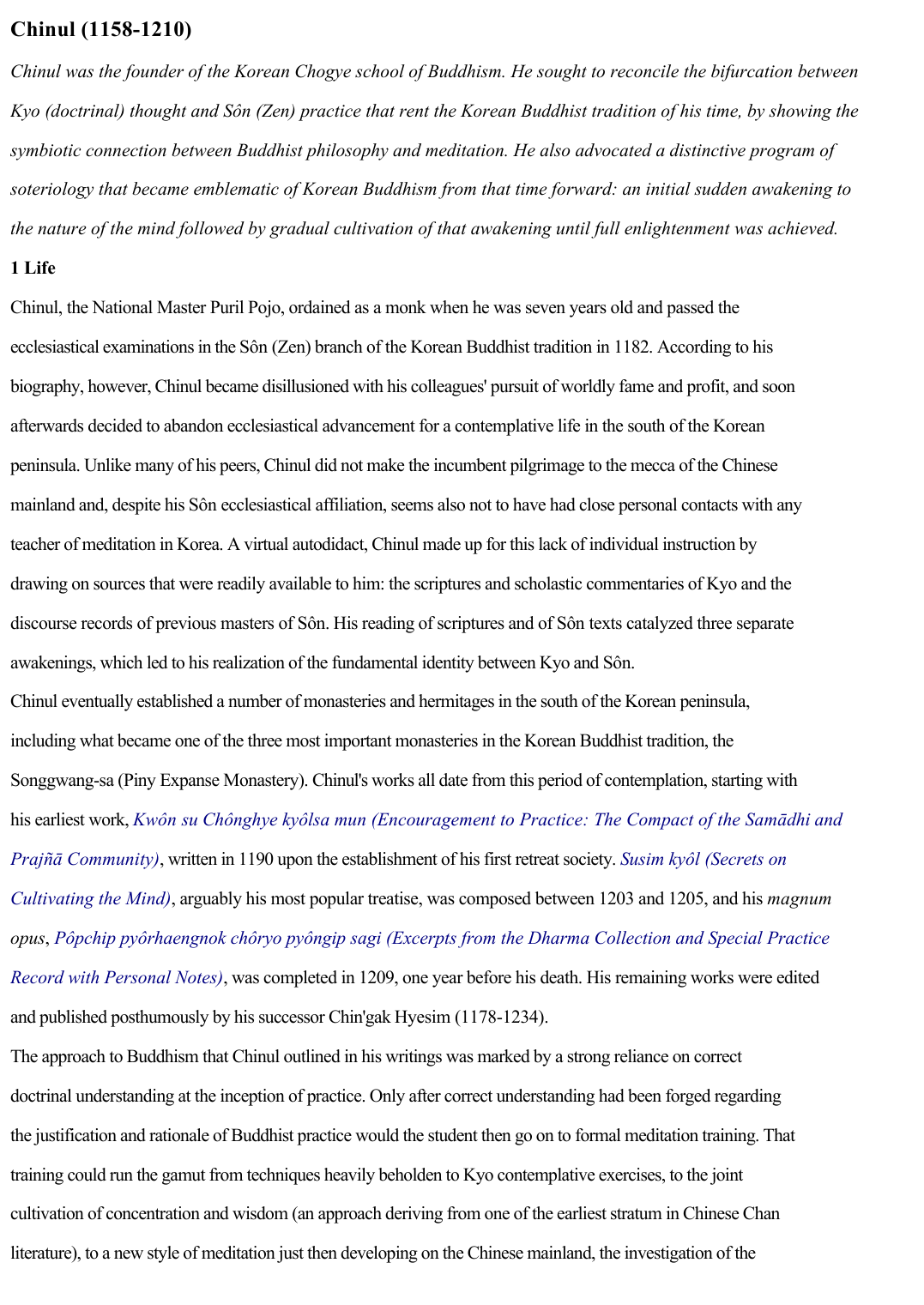Chinul
Publié le 16/05/2020

Extrait du document
«
Chinul (1158-1210)
Chinul was the founder of the Korean Chogye school of Buddhism.
He sought to reconcile the bifurcation between
Kyo (doctrinal) thought and Sôn (Zen) practice that rent the Korean Buddhist tradition of his time, by showing the
symbiotic connection between Buddhist philosophy and meditation.
He also advocated a distinctive program of
soteriology that became emblematic of Korean Buddhism from that time forward: an initial sudden awakening to
the nature of the mind followed by gradual cultivation of that awakening until full enlightenment was achieved.
1 Life
Chinul, the National Master Puril Pojo, ordained as a monk when he was seven years old and passed the
ecclesiastical examinations in the Sôn (Zen) branch of the Korean Buddhist tradition in 1182.
According to his
biography, however, Chinul became disillusioned with his colleagues' pursuit of worldly fame and profit, and soon
afterwards decided to abandon ecclesiastical advancement for a contemplative life in the south of the Korean
peninsula.
Unlike many of his peers, Chinul did not make the incumbent pilgrimage to the mecca of the Chinese
mainland and, despite his Sôn ecclesiastical affiliation, seems also not to have had close personal contacts with any
teacher of meditation in Korea.
A virtual autodidact, Chinul made up for this lack of individual instruction by
drawing on sources that were readily available to him: the scriptures and scholastic commentaries of Kyo and the
discourse records of previous masters of Sôn .
His reading of scriptures and of Sôn texts catalyzed three separate
awakenings, which led to his realization of the fundamental identity between Kyo and Sôn .
Chinul eventually established a number of monasteries and hermitages in the south of the Korean peninsula,
including what became one of the three most important monasteries in the Korean Buddhist tradition, the
Songgwang-sa (Piny Expanse Monastery).
Chinul's works all date from this period of contemplation, starting with
his earliest work, Kwôn su Chônghye kyôlsa mun (Encouragement to Practice: The Compact of the Samādhi and
Prajñ ā Community) , written in 1190 upon the establishment of his first retreat society.
Susim kyôl (Secrets on
Cultivating the Mind) , arguably his most popular treatise, was composed between 1203 and 1205, and his magnum
opus , Pôpchip pyôrhaengnok chôryo pyôngip sagi (Excerpts from the Dharma Collection and Special Practice
Record with Personal Notes) , was completed in 1209, one year before his death.
His remaining works were edited
and published posthumously by his successor Chin'gak Hyesim (1178-1234).
The approach to Buddhism that Chinul outlined in his writings was marked by a strong reliance on correct
doctrinal understanding at the inception of practice.
Only after correct understanding had been forged regarding
the justification and rationale of Buddhist practice would the student then go on to formal meditation training.
That
training could run the gamut from techniques heavily beholden to Kyo contemplative exercises, to the joint
cultivation of concentration and wisdom (an approach deriving from one of the earliest stratum in Chinese Chan
literature), to a new style of meditation just then developing on the Chinese mainland, the investigation of the.
»
↓↓↓ APERÇU DU DOCUMENT ↓↓↓


